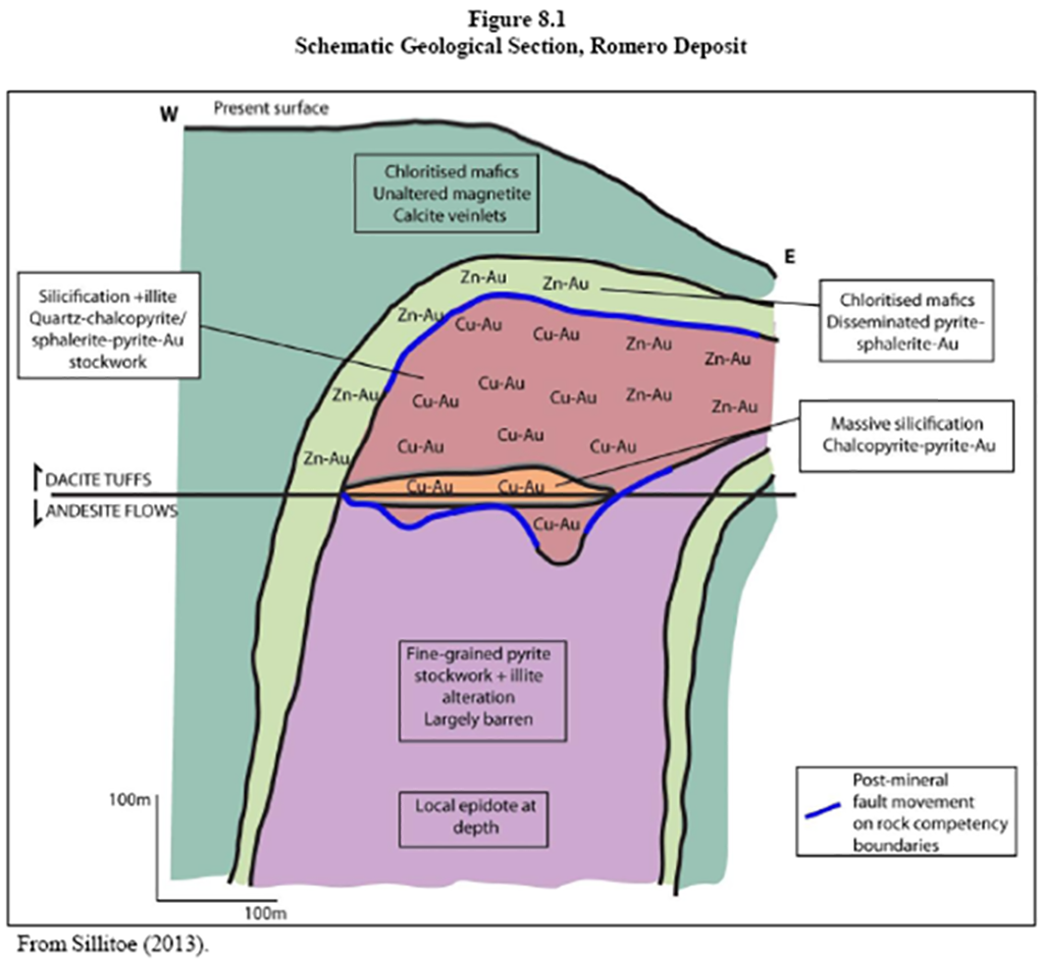For a PDF of this paper click here
Summary
The Romero gold copper zinc silver deposits are located in the Province of San Juan, Dominican Republic, approximately 165 km west-northwest of Santo Domingo. Romero and Romero South orebodies contain stratabound gold mineralization with copper, silver and zinc of intermediate sulphidation epithermal style. The gold mineralization is associated with disseminated to semi-massive sulphides, sulphide veinlets and quartz-sulphides within quartz-pyrite, quartz-illite-pyrite and illite-chlorite-pyrite alteration.
Ground DC resistivity and induced polarization (DCIP) supported by ground magnetics remain the main targeting tools for drill follow-up along with geologic mapping and geochemistry. However ZTEM™ passive airborne electromagnetics have recently also been applied with success for reconnaissance mapping of deep alteration and increased porosity regionally.
Our case-study compares ground DCIP and airborne EM-magnetic geophysical responses, supported by 3D inversions, over the known Romero and Romero South Au-Cu-Zn-Ag intermediate sulphidation deposit area.
Key words: Passive, airborne, EM, IP\Resistivity, 3D inversion, epithermal, gold.
Introduction
Romero and Romero South are intermediate epithermal gold-copper deposits that are located in the Province of San Juan, Dominican Republic, approximately 165 km west-northwest of Santo Domingo (Hennessey et al., 2014). They contain an indicated resource of 19.4 Mt at 2.63 g/t gold, 0.63% copper, 0.29% zinc and 3.7 g/t silver (Figure 1). First discovered in 2003, using stream sediment sampling, the main exploration techniques have been soil geochemistry, rock sampling and diamond drilling, assisted by ground based magnetic and induced polarization geophysics. The geophysics and drilling are used to target mineralization beneath barren cap rocks away from outcropping zones. The ground geophysical surveys identified a 3km long north-south corridor of higher conductivity, high chargeability and low magnetic susceptibility associated with hydrothermal alteration and gold mineralization known as the Romero Trend. More recently, airborne geophysics, including ZTEM™ (Z-axis tipper electromagnetics; Lo and Zang, 2008) helicopter EM-magnetic survey have been used to provide regional resistivity and magnetic information in this area of rugged terrain and difficult access.
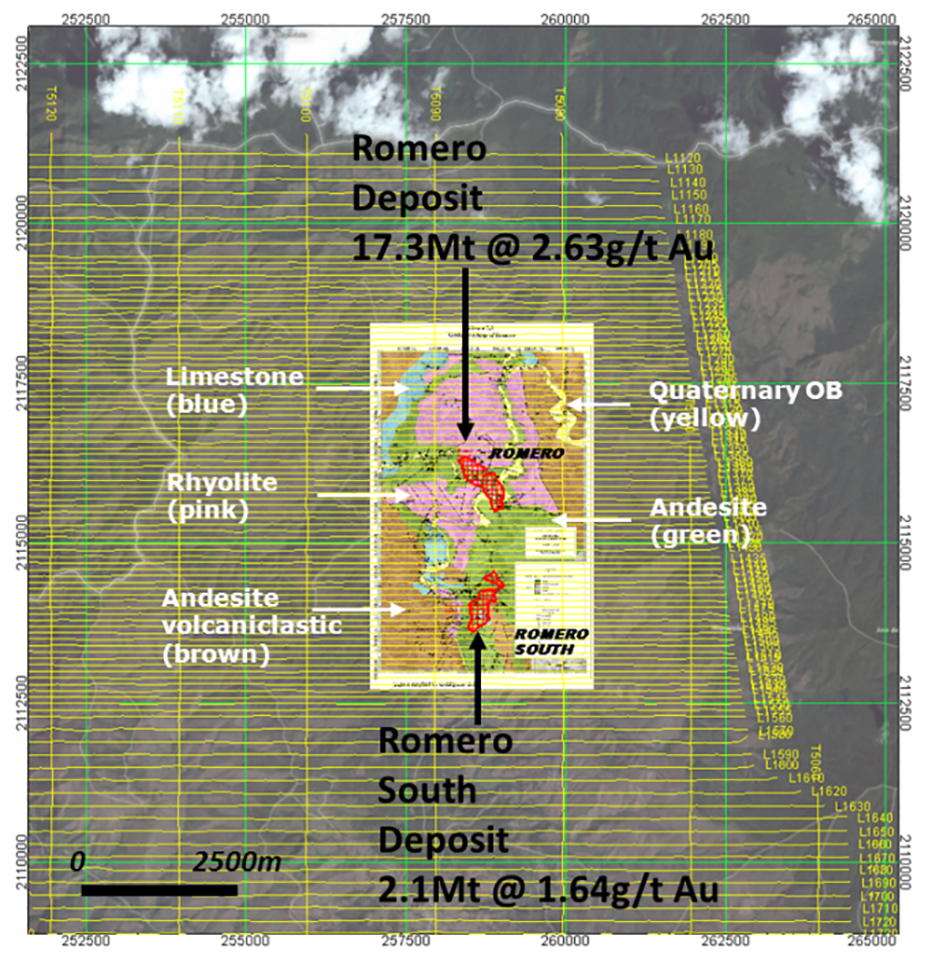
Figure 1: Geology map overlay of Romero, showing gold deposits (after Hennessey et al., 2014), and AEM-magnetic survey lines over satellite image of current study area.
Geology and Mineralization
Romero is hosted by the Cretaceous-age Tireo Formation volcanic rocks and limestones, which formed in an island arc environment. The deposit geology (Figure 1) is a relatively flat lying sequence of intercalated subaqueous, intermediate to felsic volcanic and volcaniclastic rocks and limestones on the east side of thick rhyolite flows or domes (Hennessey et al., 2014).
The Romero and Romero South deposits are flat lying and the stratabound mineralization is mainly hosted by a dacite breccia tuff (Figure 2). The mineralized horizon is capped by limestone or dacite to andesite lavas, and underlain by rhyolite or limestone. The only intrusive rock identified is a single andesite dyke (Hennessey et al., 2014).
The Romero gold mineralization with copper, silver and zinc is intermediate sulphidation epithermal in style. The source of the mineralizing fluids remains unknown and there is exploration potential for the discovery of mineralization in structural feeder zones or, possibly, in a porphyry copper-gold type system. The Romero deposit has a strike length of 1km and Romero South is about 750m (Figure 1). Both occur relatively near surface (Hennessey et al, 2014).
The mineralization is associated with quartz-pyrite, quartz-illite-pyrite and illite-chlorite-pyrite alteration. Alteration is strongest in the upper part of the mineralized zone and decreases in intensity with depth. Gold mineralization is associated with disseminated to semi-massive sulphides, sulphide veinlets and quartz-sulphides. The sulphides comprise pyrite with sphalerite, chalcopyrite and galena (Figure 2). Oxidation is shallow, to a depth of 10 m to 15 m (Hennessey et al., 2014).
Geophysical Target Model
The hydrothermal alteration and precious/gold mineralization at Romero have been assigned an epigenetic intermediate sulphidation (IS) epithermal style by Silitoe (2013). IS epithermal gold deposits share similar alteration mineral assemblages as low sulphidation (LS) systems but like high sulphidation (HS) are more base-metal rich and spatially associated with intrusions (Taylor, 2007).
The geophysical characteristics of IS deposits are not well described in the literature, for example Hoschke (2011) outlines the differences in geophysical signatures between HS and LS epithermal gold deposits but does not mention IS specifically.
However, based on the geophysical characteristics of Romero (i.e., low resistivity from illite-smectite-pyrite alteration, high chargeability from abundant pyritic sulphides and low magnetism from magnetite destruction; ref. Niemi, 2014), it appears to share closer geophysical resemblance to HS signatures. Indeed Kwan et al. (2014) note similar geophysical characteristics at the Cerro Quema HS deposit in Panama; whereas Legault et al. (2012a) describe high resistivity signatures over the Gold Springs LS gold deposits in Nevada.
Regardless, because of the massive silicification that is also present at Romero, as shown in Figure 2, we should expect that, depending on the erosional level or size and source depth or dryness conditions, that high resistivity signatures from the silica and quartz-alunite alteration typically found in the centre of HS deposits may also be observed, as shown by Hoschke (2011) and Goldie (2000) over the Yanacocha HS deposit.
IP/Resistivity and Passive AEM Results
Ground IP/Resistivity
Ground IP surveys were first surveyed at Romero by Quantec Geoscience Ltd. (Toronto, CAN) in 2011 and from 2012 to present by Insight Geophysics Inc. (Oakville, CAN) using Gradient array and Insight (multiple Gradient) sections (Hennessey et al., 2014). The Gradient or Modified Schlumberger array is effective for economically covering large areas and uses receiver potential electrodes that are moved in a profile up and down lines between two fixed transmitter current electrodes (Telford et al., 1990).
For Gradient arrays the effective depth of investigation (Ze) is controlled by the current electrode separation (L=AB) according to Ze=0.190L (Edwards, 1977). Hence by expanding or contracting the transmitter array, anomalies can be further detailed in a vertical dimension and plotted in a pseudo section format termed Insight Sections (Pawluk, 2014).
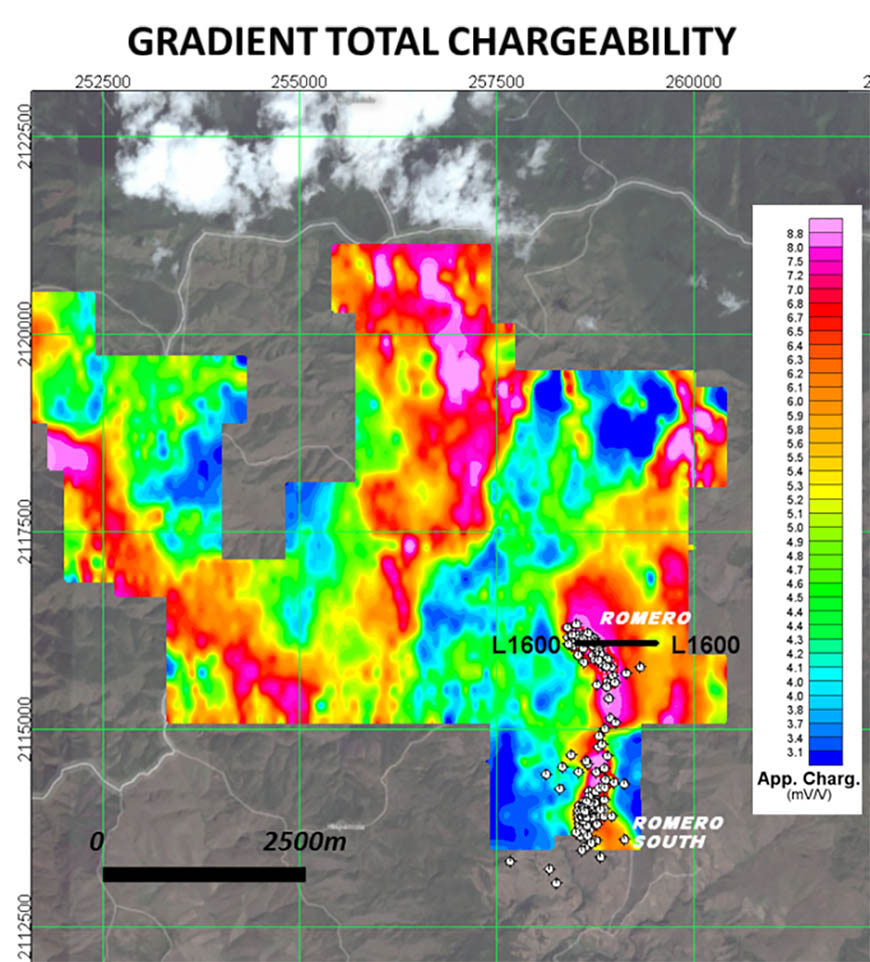
Figure 3: Gradient apparent chargeability map, showing Romero and Romero South locations and drillholes, and location of Insight sections in Fig. 5.
The Insight Section is composed of a fixed array of potential electrodes (typically 40) with a potential dipole separation (MN) of 25 or 50 metres. Starting at the centre location of the Insight Section, multiple current injections at various AB lengths are used to create vertical geo-electric soundings beneath each of the receiver potential dipoles. AB lengths used to create an Insight Section typically range from 5MN to 100MN (Pawluk, 2014).
At Romero, the time-domain IP survey consisted of multiple AB injections (100m to 2500m), a 50m receiver MN spacing, a 25m sampling interval and a line separation of 200m. The maximum depth of coverage (Ze) is estimated at approx. 500m. The transmitted waveform was a 4-second square wave with 50% duty cycle. Total chargeabilities were obtained by integrating 20 semi-logarithmic off-time decay windows between 160-3680ms (Pawluk, 2014). Figure 3 presents the gradient array IP total chargeability plan and Insight IP and apparent resistivity pseudo-sections over Romero deposit in Figure 4. They show decreased resistivity above the zone and along the edges and increased chargeabilities at depth within the Romero zone that extends below the DCIP coverage.
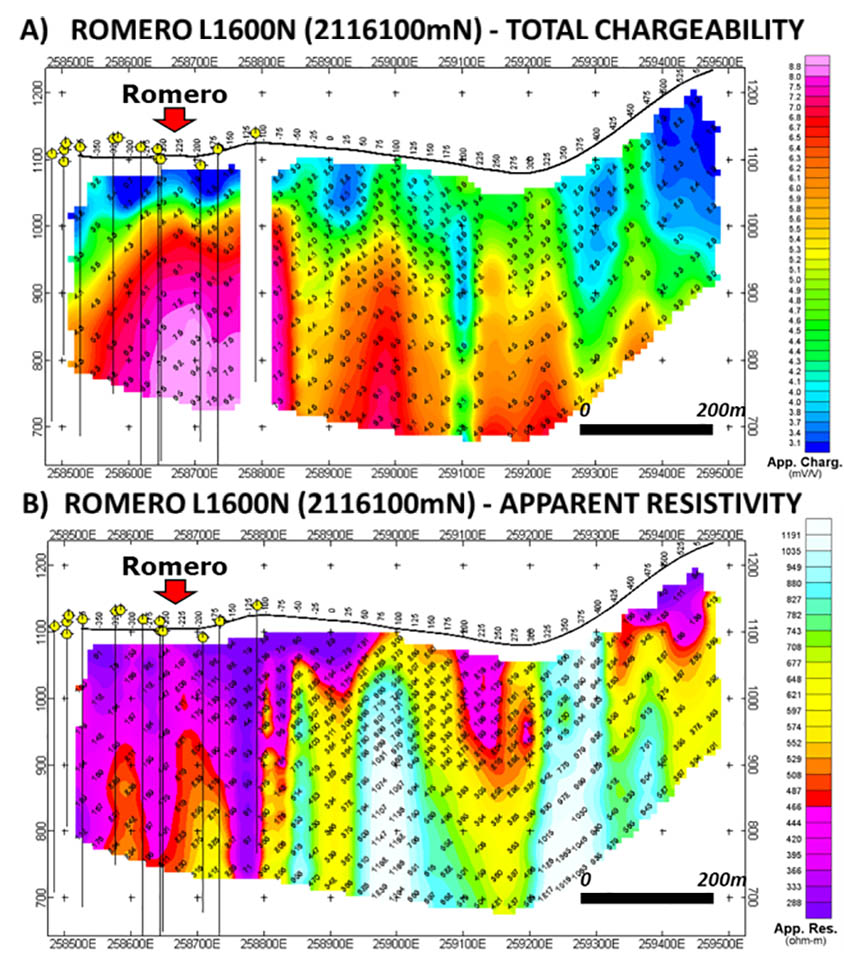
Figure 4: Total chargeability (A) and apparent resistivity (B) Insight pseudo-sections over Romero Deposit, showing NS-projected drillholes in vicinity.
Airborne EM-Magnetics
Prior to the current AEM survey, only a regional aeromagnetic and radiometric survey at 1km line-spacing had been flown over Romero in 2002-2004 (Hennessey et al., 2014). The ZTEM™ passive AFMAG (Labson et al., 1985) helicopter EM and aeromagnetic survey was flown in February-March, 2014. It consisted of 3195 line-kilometres of coverage using 100-200m line-spacings and avg. bird-heights of 140m and 155m for the EM and magnetic sensors. ZTEM™ tipper data (Tzx in-line & Tzy cross-line) were acquired at 6 frequencies (30-720Hz). Readers can refer to Legault et al., (2012b) for additional descriptions of the ZTEM™ system and theory.
he reduced-to-pole total magnetic intensity over a smaller 12x12km area that focuses on the Romero gold-copper deposits is presented in Figure 5. A well-defined magnetic low that reflects magnetite-depletion/destruction due to hydrothermal alteration is centred on the deposits. Surrounding magnetic highs are from unaltered intermediate volcanic country rocks.
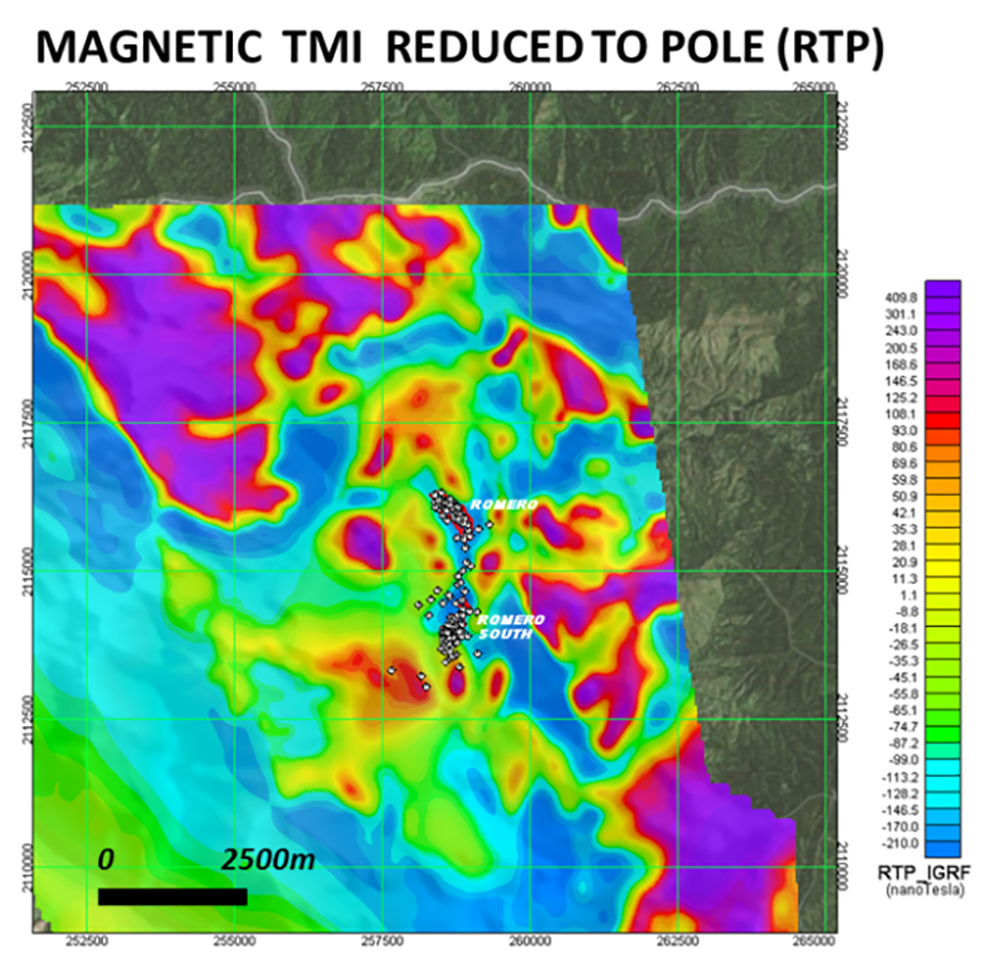
Figure 5: Magnetic TMI reduced to pole (RTP), showing magnetic low over Romero and Romero South deposits.
Figure 6 presents the ZTEM™ total phase rotated (TPR) In-phase tipper results at 90Hz which show that Romero and Romero South are aligned along a prominent NW-SE conductive trend that extends >10km along strike. Figure 7 presents a resistivity depth slice at 500m from 3D ZTEM™ inversion performed using the UBC MT3dinv code of Holtham and Oldenburg (2008). It shows a well-defined resistivity low that extends between Romero and Romero South deposits, suggesting that the two mineralized alteration systems are joined at depth. This appears to be confirmed in later follow-up drilling below 500m between the two deposits (Niemi, 2014). Figure 8 compares the 3D ZTEM™ resistivity section over Romero and the 3D magnetic susceptibility section obtained using the UBC Mag3D code (Li and Oldenburg, 1996) that highlight the deep resistivity low and mag-susceptibility low below the Romero IS epithermal deposit.
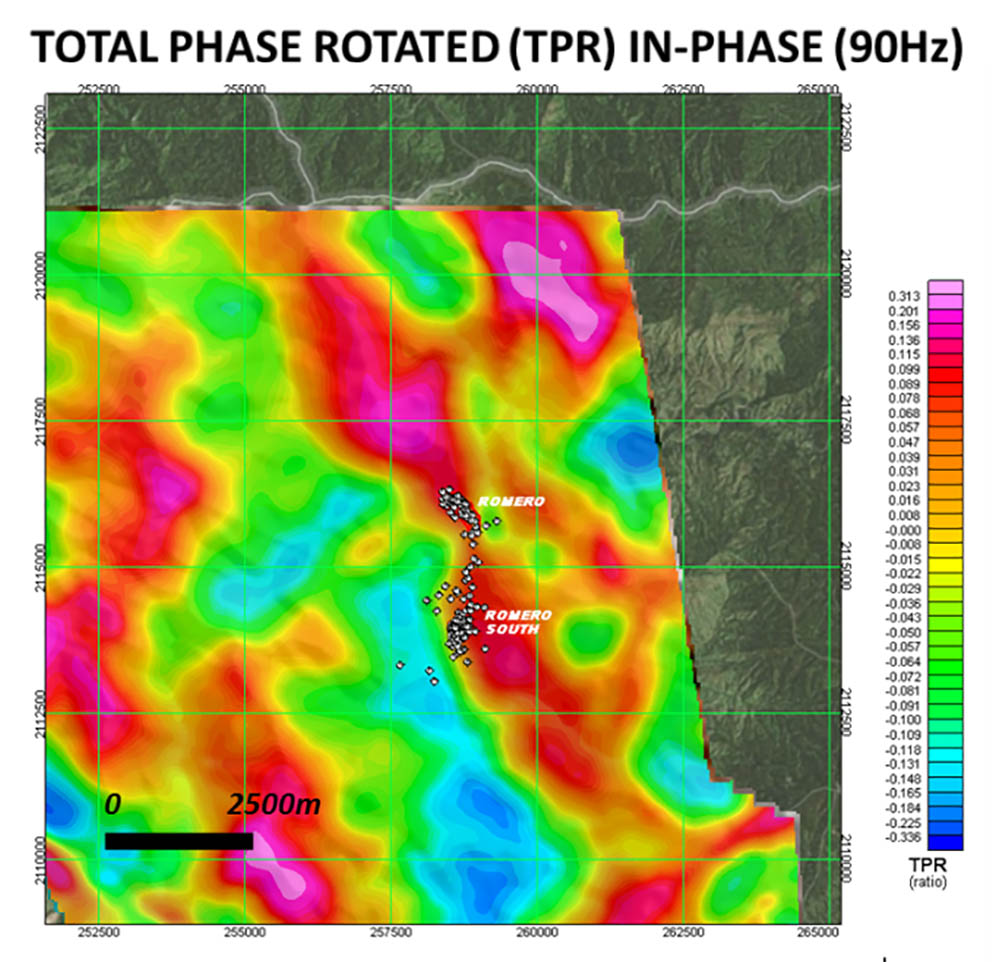
Figure 6: ZTEM™ Total phase rotated (TPR) In-phase tipper, showing NW-SE trending resistivity low extending across Romero and Romero South deposits.
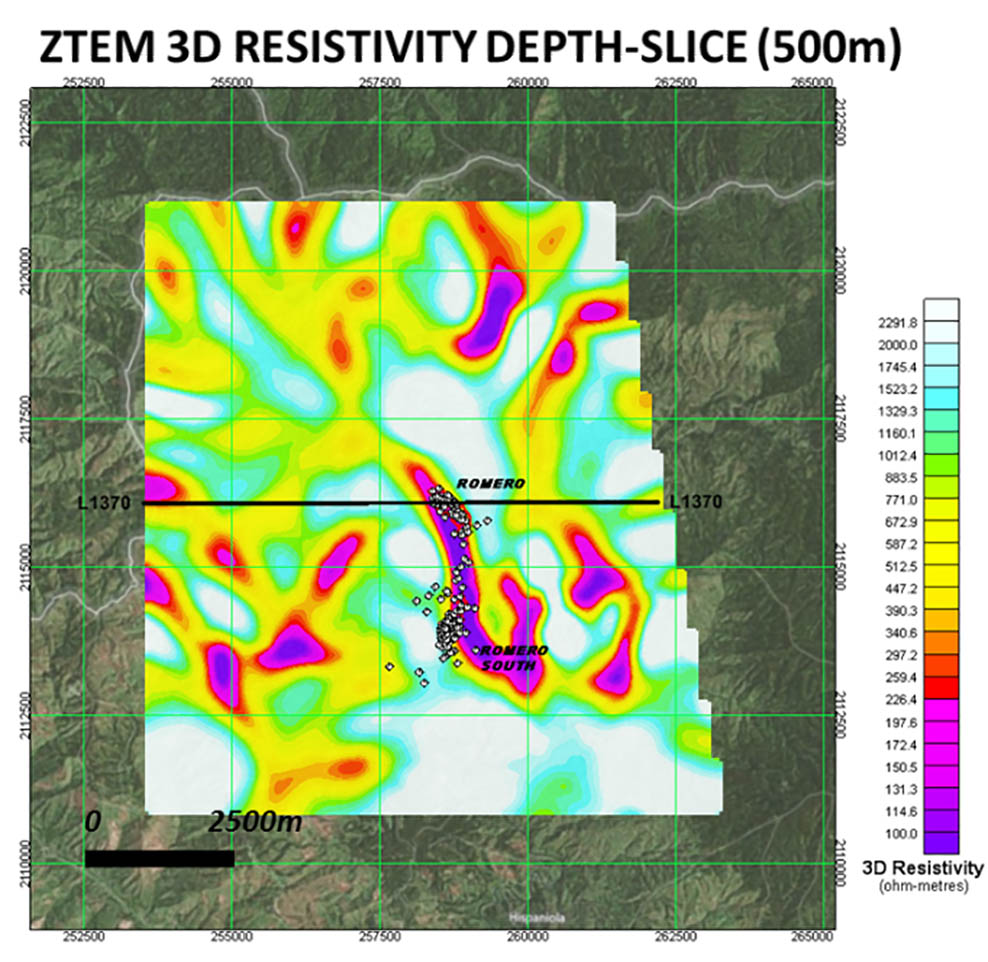
Figure 7: ZTEM™ 3D Inversion results, showing 500m resistivity depth-slice, highlighting NW-SE resistivity low extending from Romero to Romero South, and L1370 below.
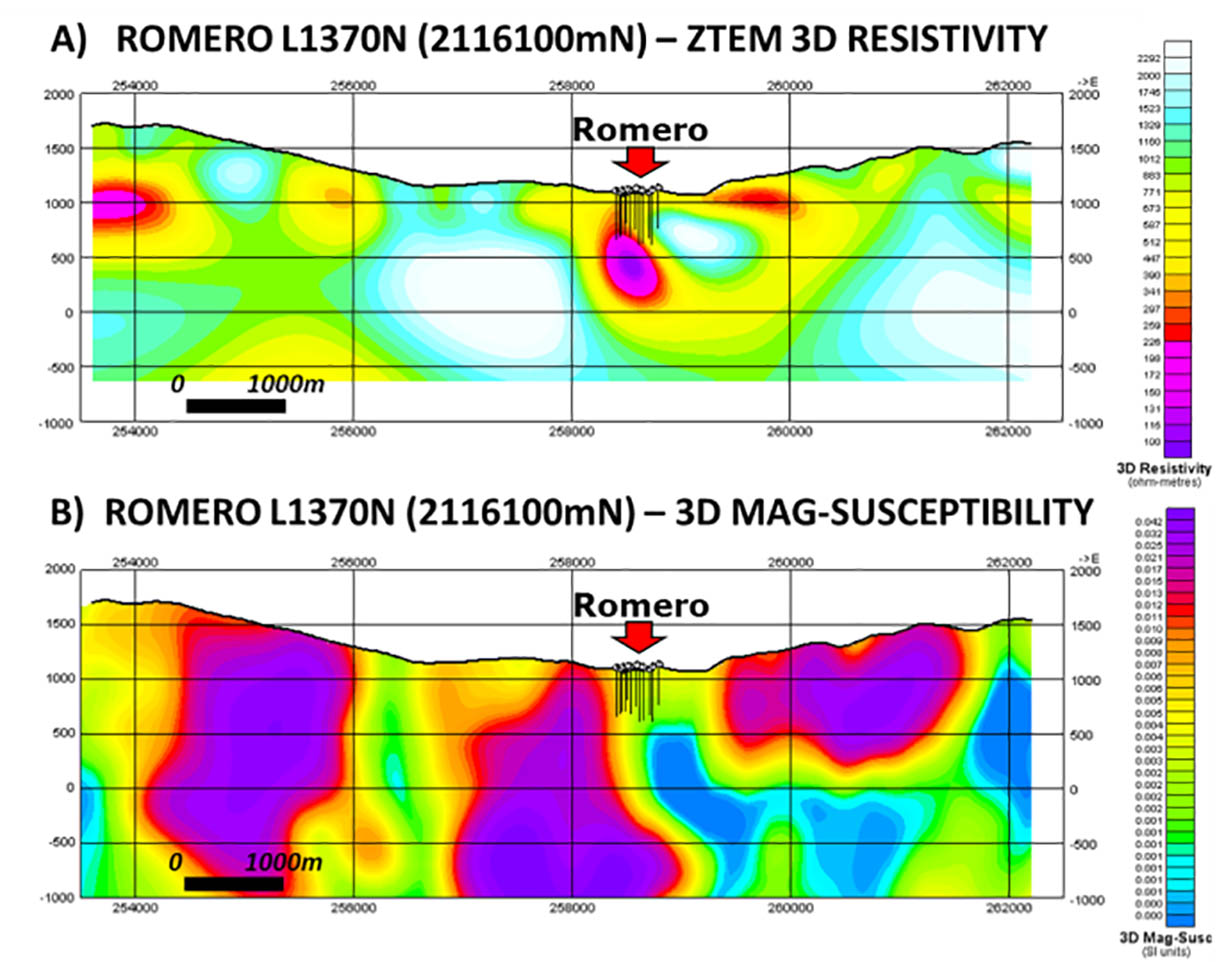
Figure 8a) ZTEM™ 3D resistivity and 3b) 3D magnetic inversion sections over Romero deposit, showing drillholes.
Conclusions
Exploration for Romero-type intermediate sulphidation (IS) polymetallic gold-copper-zinc-silver deposits has focused on: ground magnetic lows indicating magnetite-depletion/alteration, as well as ground resistivity lows indicating altered /porous host rocks and ground chargeability highs indicating presence of sulphides, in combination with geologic mapping, drilling and soil geochemistry. Airborne ZTEM passive EM surveys have provided rapid reconnaissance mapping of bedrock alteration/porosity, improved depth of investigation (>500m) and improved magnetic mapping, thereby providing follow-up targets for ground IP\resistivity surveys and deep targeted drilling. ZTEM results were successful in identifying a previously unknown deep (>500m) continuity between Romero & Romero South deposits.
Acknowledgements
The authors wish to thank GoldQuest Mining Corp. for permission to show these results. We also thank Craig Pawluk and Insight Geophysics for the ground DCIP data acquisition.
References
Edwards, L.S., 1977, A modified pseudo section from resistivity and IP: Geophysics, 42, 1020-1036.
Goldie, M.K., 2000, A geophysical case history of the Yanacocha gold district, northern Peru: SEG Expanded Abstracts, 750-753, doi: 10.1190/1.1816178.
Hennessey, B.T., San Martin, A.J., Gowans, R.M., Dreesbach, C., and Jacobs, C., 2013, Preliminary economic assessment (PEA) for the Romero project, Tireo property, Province of San Juan, Dominican Republic: NI 43-101 technical report for GoldQuest Mining Corp. by Micon International Ltd., 233 p.
Holtham, E. and Oldenburg, D.W., 2008, Three-dimensional forward modelling and inversion of Z-TEM data: SEG Expanded Abstracts, 564-568.
Kwan, K., Prikhodko, A., Legault, J.M., Plastow, G., Kapetas, J. and Druecker, M., 2014, VTEM airborne EM, aeromagnetic and gamma-ray spectrometric data over the Cerro Quema high sulphidation epithermal gold deposits, Panama: submitted to ASEG-PESA 2015.
Labson, V. F., A. Becker, H.F. Morrison, and U. Conti, 1985. Geophysical exploration with audio-frequency natural magnetic fields: Geophysics, 50, 656–664.
Legault, J.M., S. Zhao, and R. Fitch, 2012a, ZTEM airborne AFMAG survey results over low sulphidation epithermal gold-silver vein systems at Gold Springs, south eastern Nevada: ASEG Extended Abstracts, 4 p.
Legault, J.M., Wilson G., Gribenko A., Zhdanov, M. S., Zhao, S. and Fisk, K., 2012b, An overview of the ZTEM and AirMt airborne electromagnetic systems – A case study from the Nebo-Babel Ni-Cu-PGE deposit, West Musgrave, Western Australia: Preview, 158, 26-32.
Li, Y., and Oldenburg, D.W., 1996, 3-D inversion of magnetic data, Geophysics, 61, 394-408.
Lo, B., and M. Zang, 2008, Numerical modeling of Z-TEM (airborne AFMAG) responses to guide exploration strategies: SEG Expanded Abstracts, 1098-1101.
Niemi, J., 2014, Developing resources in and above the ground – Gold and copper development in the Dominican Republic: GoldQuest corporate presentation, June-2014 (www.goldquest.com).
Pawluk, C., 2014, Insight survey description: personal communication, 6 p.
Silitoe, R.H., 2013, Comments on Geology and Exploration of the Romero Gold-Copper Prospect and Environs, Las Tres Palmas Project, Dominican Republic: Report for GoldQuest Mining Corp., 9 p., (www.goldquest.com).
Taylor, B.E., 2007, Epithermal gold deposits, in Goodfellow, W.D., ed., Mineral Deposits of Canada: A Synthesis of Major Deposit-Types, District Metallogeny, the Evolution of Geological Provinces, and Exploration Methods: Geological Association of Canada, Mineral Deposits Division, Special Publication No. 5, p. 113-139.
Telford, W.M., Geldart, L.P., and Sheriff, R.E., 1990, Applied Geophysics, Second Edition: Cambridge University Press.
